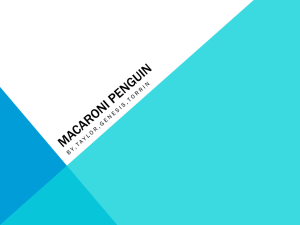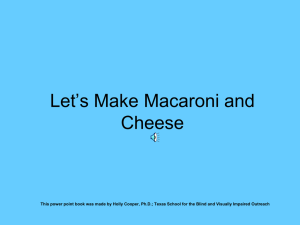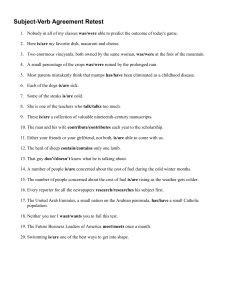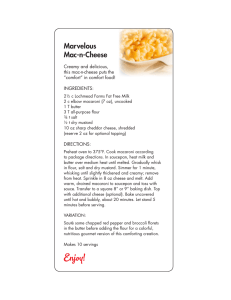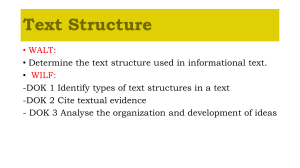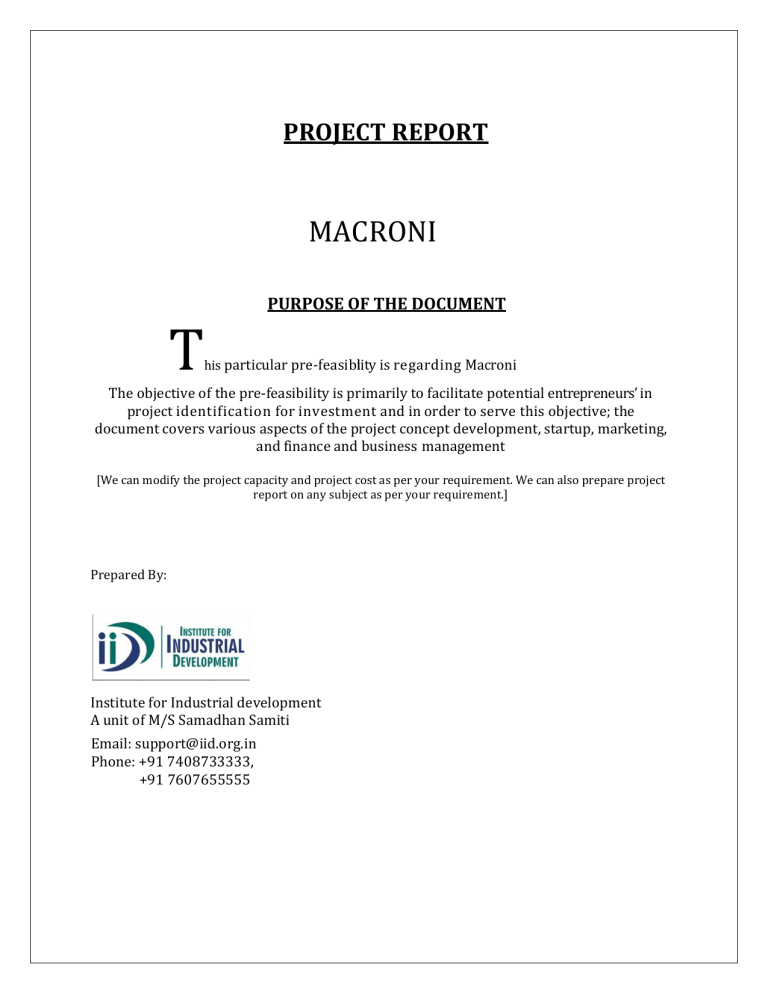
PROJECT REPORT T MACRONI PURPOSE OF THE DOCUMENT his particular pre-feasibility is regarding Macroni The objective of the pre-feasibility is primarily to facilitate potential entrepreneurs’ in project identification for investment and in order to serve this objective; the document covers various aspects of the project concept development, startup, marketing, and finance and business management [We can modify the project capacity and project cost as per your requirement. We can also prepare project report on any subject as per your requirement.] Prepared By: Institute for Industrial development A unit of M/S Samadhan Samiti Email: support@iid.org.in Phone: +91 7408733333, +91 7607655555 MACARONI UNIT Introduction Macaroni is dry pasta shaped like narrow tubes. Made with durum wheat, macaroni is commonly cut in short lengths; curved macaroni may be referred to as elbow macaroni. Some home machines can make macaroni shapes, but like most pasta, macaroni is usually made commercially by large-scale extrusion. The curved shape is created by different speeds of extrusion on opposite sides of the pasta tube as it comes out of the machine. Macaroni is becoming extremely popular in India even as Continental and Italian delicacy. Cereals like wheat, rice, maize and millets are staple food grain for majority of population around the world. These are the rich source of carbohydrates and supply of calorie and other nutrients to the consumers. Apart from value addition by processing to traditional products from these grains, development of new products offers Variety, Convenience, Quality, Cost efficiency and Scope for increasing nutritional value. In the developed countries many convenience foods are prepared by extrusion process using extruder, as it offers a large number of desired characteristics to be incorporated in the product. Ingredients Macaroni is made from Fine semolina (Suji), Wheat flour, Milk solid is the main ingredients in pasta. Qualities of Macaroni 1. Easy to prepare 2. Lower In fat. 3. It has right thickness, allowing it to cook evenly 4. It remains compact, strong and elastic, even many hours it has been cooked. Description of Macaroni Machine Although macaroni & Pasta products were first introduced in Italy in the 13th century, efficient manufacturing equipment and high-quality ingredients have been available only since the 20th century. Prior to the industrial revolution, most Macaroni products were made by hand in small shops. Today, most macaroni is manufactured by continuous, high capacity extruders, which operate on the auger extrusion principle in which kneading and extrusion are performed in a single operation Macaroni Machines are used to produce pasta from the raw material. With the help of this machine the work of mixing, extruding, drying& packaging completes in a very short span. Macaroni Market Analysis The popularity of macaroni can be attributed to its sensory appeal, Versatility, Low Cost, ease of preparation, Nutritional content and excellent storage stability as well as increased consumer interest in ethnic foods in the Western world. The demand for macaroni is gaining immense popularity in India, particularly amongst the younger population, due to expansion in food-service restaurants. “Indian Macaroni & Pasta Market: Industry Trends, Share, Size, Growth, Opportunity and Forecast 2018-2023”, the Macaroni & pasta market in India reached a sales value of US$ 286.6 Million in 2017, exhibiting a CAGR of 17.1% during 2010-2017. As noodle’s main ingredients is all purpose flour (Maida), which is very bad for human apatite where pasta came from Semolina, which is good in nutrition and very easy to enzyme. Urbanization is the key factor of pasta business. The primary factors catalysing the growth of the pasta market in India include rising urbanisation, changing lifestyles and surging demand for ready-to-eat products. In addition to this, the market is also influenced by an increasing women employment rate coupled with rising disposable incomes. Further, the health-conscious consumers are demanding food products with healthier ingredients, which have led to a rise in the demand for macaroni made with whole-wheat. Some of the other forces that have been proactive in maintaining the market growth are longer shelf-life and ease of preparation. Looking forward, the market is registering a CAGR of 16.2% during 2018-2023, Macaroni product have good potential especially in the Middle east/south east Asia. Automatic Macaroni Manufacturing Process Step 1: Take Semolina (Rava) of different batches like 300 KG/hour, 500 KG/hour, 100 KG/hour, which depends upon the machine capacity and pour it into the hopper. Step 2: After that with the help of screw conveyer (of 12 feet, made of stainless steel) the rava is fed into the online mixer and then add water accordingly. Step 3: Mix for 15-20 minutes by maintaining the temperature accordingly. Step 4: After Mixing pour it into macaroni extruder made of mild steel. Step 5: Now, use the moulds for different types of shapes required for pasta and fed into the vibro feeder. Step 6: After that dry the pasta with the help of static dryer & packed the macaroni for selling it into the market. Machinery &Equipment’s required: For 50 KG/Hour semi Automatic Capacity Description Quantity Value Batch Mixer 1 50,000 Macaroni & Pasta Mixer 1 4,50,000 Static Dryer 1 3,00,000 Total Cost 3 8,00,000 * Machine Value is exclusive of GST & other transportation cost. Note: We can also prepare pasta with different capacity like: 100KG/hour, 200KG/Hour, 300KG/hour, 500KG/Hour and 1000KG/Hour. Work sheet For Macaroni Manufacturing Parameters Design Capacity 50 KG per hour Working hours in day (2 shift of 8 hours each) 16 hours Production per day 800 KG Furniture & Fixture Requirement: Cost of office furniture (Table, chairs, workstation): Rs. 1,00,000. Raw Material Requirement Durum Wheat Semolina (cost per KG) = Rs. 24 Labour Requirement: 2 Manpower are required for the macaroni unit. Includes: 1 skilled labour 1 unskilled Labour Land &Building required: Land required 650-700 Square Feet (approx.) Approximate rent for the same is 13000 per Month. Macaroni License &Registration For Proprietorship Obtain the GST registration. Fire/ Pollution Registration as required. Choice of a Brand Name of the product and secure the name with Trademark if required. Implementation Schedule S.N. Activity Time Required (In Months) 1 Registration, Licensing selection of site, statutory, 2 Order to Machine, Raw material & recruitment 1 Month 3 Training & market survey 1 Month 4 Commissioning & commercial production 1 Month 5 Arrangement of Finance 1 month Total time Required (some activities shall rum simultaneously) 1 Month 2-3 months (approx.) Conclusion: After completion of manufacturing process, product is ready to sell in the market. Pasta is very easy to cook & can be prepared in a very short time. This machine can be installed with small investment & one can earn a good Margin profit if having knowledge about doing this business. Pasta product has a very good market potential. Technical Process Flow Chart Automatic Macaroni Manufacturing Process Step 2 • Pour raw material into the hopper. • Fed Rava into the online Mixer & add water accordingly. • Maintain the temperature & Mix The batter for 15-20 minutes. Step 3 Step1 Step 5 •Dry the macaroni with the help of static dryer and packaging. •After that transportation of goods. Step6 • Shape the macaroni with the help of moulds. • Pour the mixture into macaroni extruder & control its speed. Step 4 PROJECT AT A GLANCE 1 2 3 4 Name of the Entreprenuer Constitution (legal Status) : Father's/Spouce's Name Unit Address xx xx xx : xx xx Taluk/Block: District : Pin: E-Mail : Mobile 5 6 7 8 9 10 11 12 13 Product and By Product Name of the project / business activity proposed : Cost of Project Means of Finance Term Loan xx xx Macaroni Rs. 10.44 Rs. 9.40 25% of 10.44 Lacs Rs. (2.61 Lacs) Rs. - KVIC Margin Money Own Capital Debt Service Coverage Ratio Pay Back Period Project Implementation Period 6 years 6 months Employment Power Requirement 5 KW connection 14 Major Raw materials Estimated Annual Sales Turnover 15 Detailed Cost of Project & Means of 16 Finance COST OF PROJECT Rava/ selomina 47.19 Lacs (at 65% capacity) (Rs. In Lacs) Particulars Amount Land Building & Civil Work Plant & Machinery Furniture & Fixtures 9.44 1.00 Pre-operative Expenses Contingencies Working Capital Requirement 10.00 Total 20.44 MEANS OF FINANCE Particulars Amount Own Contribution 2.04 Bank Finance working capital from bank 9.40 Total KVIC Margin Money 9.00 20.44 25% of 10.44 Lacs (2.61 Lacs) FINANCIAL ASSISTANCE REQUIRED Term Loan of Rs.9.40 Lacs and Working Capital limit of Rs. 9.00 Lacs COST OF PROJECT PARTICULARS AMOUNT AMOUNT AMOUNT 10.00% 90.00% 9.44 0.94 8.50 1.00 0.10 0.90 Working capital 10.00 1.00 9.00 Total 20.44 2.04 18.40 Building Civil Work Plant & Machinery Furniture & Fixtures MEANS OF FINANCE PARTICULARS AMOUNT Own Contribution 2.04 Bank Loan 9.40 Working capital Limit 9.00 Total 20.44 COMPUTATION OF PRODUCTION OF MACARONI Items to be Manufactured Macaroni Machine Capacity 50KG per hour Per day capacity 800 Per annum Capacity KG 240,000 KG Wastage 3.00% Of input Total Raw material Requirement Raw Material required per day 825KG Raw Material(Suji) Per Annum 247423KG CALULATION OF CONSUMPTION OF RAW MATERIAL Item Name At Capacity Raw Material 100% Quantity of Raw Material 247,423 Raw Material Consumed Capacity Rate per Kg Utilisation Amount (Rs. in lacs) 1st year 65% 24.00 38.60 2nd year 70% 24.72 42.81 3rd year 75% 25.46 47.25 4th year 80% 26.23 51.91 5th year 85% 27.01 56.81 6th year 90% 27.82 61.96 COMPUTATION OF SALE Particulars 1st year 2nd year 3rd year 4th year 5th year 6th year - 13,000 14,000 15,000 16,000 17,000 Production 156,000 168,000 180,000 192,000 204,000 216,000 Less : Closing Stock 13,000 14,000 15,000 16,000 17,000 18,000 Net Sale 143,000 167,000 179,000 191,000 203,000 215,000 sale price per KG Sales Value (in Lacs) 33.00 34.00 35.00 36.00 37.00 38.00 47.19 56.78 62.65 68.76 75.11 81.70 Op Stock BREAK UP OF LABOUR CHARGES Particulars Wages No of Total Per Month Employees Salary Skilled labour 15000 1 15000 Unskilled labour 8000 1 8000 Total Salary Per Month Total Annual Labour Charges 23000 (in Lacs) 2.76 Utility Charges at 100% capacity (per month) Particulars value Description Power connection required 5 KWH consumption per day 80 units 2000 units 7 Rs. 14000 Rs. Consumption per month Rate per Unit power Bill per month PROJECTED PROFITABILITY STATEMENT PARTICULARS 1st year 2nd year 3rd year 4th year 5th year 6th year 65% 70% Macroni 47.19 56.78 62.65 68.76 75.11 81.70 Total 47.19 56.78 62.65 68.76 75.11 81.70 38.60 42.81 47.25 51.91 56.81 61.96 Elecricity Expenses 1.68 1.76 1.94 2.13 2.35 2.58 Repair & Maintenance 0.33 0.40 0.44 0.48 0.53 0.57 Labour & Wages 2.76 3.17 3.49 3.84 4.22 4.65 Consumables 0.57 0.68 0.75 0.83 0.90 0.98 43.93 48.83 53.87 59.19 64.81 70.74 Capacity Utilisation % 75% 80% 85% 90% SALES Gross Sale COST OF SALES Raw Mateiral Consumed Cost of Production Add: Opening Stock /WIP - 3.66 4.07 4.49 4.93 5.40 Less: Closing Stock /WIP 3.66 4.07 4.49 4.93 5.40 5.89 40.27 48.42 53.45 58.75 64.34 70.24 GROSS PROFIT 6.92 8.36 9.20 10.01 10.77 11.46 Depriciation 1.52 1.29 1.10 0.94 0.80 0.69 Interest on Term Loan 1.02 0.99 0.85 0.70 0.24 0.10 Interest on working Capital 0.99 0.99 0.99 0.99 0.99 0.99 rent 1.56 1.79 2.06 2.37 2.73 3.14 Selling & Adm Expenses Exp. 0.14 0.45 1.25 1.55 1.69 1.84 TOTAL 5.23 5.52 6.26 6.55 6.46 6.75 Cost of Sales NET PROFIT Taxation PROFIT (After Tax) 1.69 2.84 2.94 3.46 4.31 4.70 - - - - - - 1.69 2.84 2.94 3.46 4.31 4.70 PROJECTED BALANCE SHEET PARTICULARS 1st year 2nd year 3rd year 4th year 5th year 6th year Liabilities Capital opening balance 3.23 5.57 7.01 8.57 10.38 Add:- Own Capital 2.04 Add:- Retained Profit 1.69 2.84 2.94 3.46 4.31 4.70 Less:- Drawings 0.50 0.50 1.50 1.90 2.50 1.75 Closing Blance 3.23 5.57 7.01 8.57 10.38 13.34 Subsidy for reserve 2.61 2.61 2.61 Term Loan 8.80 7.60 6.40 2.59 1.39 - Working Capital Limit 9.00 9.00 9.00 9.00 9.00 9.00 Sundry Creditors 0.64 0.71 0.79 0.87 0.95 1.03 Provisions & Other Liab 0.50 0.75 0.90 1.08 1.35 1.62 24.78 26.24 26.71 22.10 23.07 24.99 10.44 10.44 10.44 10.44 10.44 10.44 Gross Dep. 1.52 2.81 3.91 4.86 5.66 6.35 Net Fixed Assets 8.92 7.63 6.53 5.58 4.78 4.09 FD with bank 2.61 2.61 2.61 Sundry Debtors 5.51 6.25 6.89 7.56 8.26 8.99 Stock in Hand 5.85 8.07 8.90 9.78 10.70 11.68 Cash and Bank 1.90 1.69 1.78 1.79 1.93 2.84 24.78 26.24 26.71 24.71 25.68 27.60 TOTAL : Assets Fixed Assets ( Gross) Current Assets TOTAL : PROJECTED CASH FLOW STATEMENT PARTICULARS 1st year 2nd year 3rd year 4th year 5th year 6th year SOURCES OF FUND Own Margin 2.04 Net Profit 1.69 2.84 2.94 3.46 4.31 4.70 Depriciation & Exp. W/off 1.52 1.29 1.10 0.94 0.80 0.69 Increase in Cash Credit 9.00 - - - - - Increase In Term Loan 9.40 - - - - - Increase in subsidy 2.61 - - Increase in Creditors 0.64 0.07 0.07 0.08 0.08 0.09 Increase in Provisions & Oth lib 0.50 0.25 0.15 0.18 0.27 0.27 27.40 4.45 4.27 4.66 5.47 5.75 TOTAL : APPLICATION OF FUND Increase in FD Increase in Fixed Assets 2.61 - - - 2.61 10.44 Increase in Stock 5.85 2.22 0.83 0.88 0.93 0.97 Increase in Debtors 5.51 0.74 0.65 0.67 0.70 0.72 Repayment of Term Loan 0.60 1.20 1.20 3.81 1.20 1.39 Drawings 0.50 0.50 1.50 1.90 2.50 1.75 - - - - - - Taxation TOTAL : 4.66 4.18 4.65 5.32 4.84 - 1.90 1.69 1.78 1.79 1.93 Add : Surplus 1.90 - 0.21 0.09 0.01 0.14 0.91 Closing Cash & Bank Balance 1.90 1.69 1.78 1.79 1.93 2.84 Opening Cash & Bank Balance 25.50 COMPUTATION OF CLOSING STOCK & WORKING CAPITAL PARTICULARS 1st year 2nd year 3rd year 4th year 5th year 6th year Finished Goods 3.66 4.07 4.49 4.93 5.40 5.89 Raw Material 2.19 Closing Stock 5.85 4.00 8.07 4.41 8.90 4.84 5.30 9.78 5.78 10.70 11.68 COMPUTATION OF WORKING CAPITAL REQUIREMENT TRADITIONAL METHOD Particulars Finished Goods & Raw Material Amount Stock Own Margin Bank Finance 5.85 Less : Creditors 0.64 Paid stock 5.21 10% 0.52 90% 4.68 Sundry Debtors 5.51 10% 0.55 90% 4.95 10.71 WORKING CAPITAL LIMIT DEMAND ( from Bank) 1.07 9.00 9.64 2nd Method PARTICULARS Total Current Assets 2020-21 2021-22 13.25 16.00 1.14 1.46 12.11 14.54 25% of WCG 3.03 3.63 Actual NWC 3.11 5.54 item III - IV 9.08 10.90 item III - V 9.00 9.00 MPBF (Lower of VI & VII) 9.00 9.00 Other Current Liabilities Working Capital Gap Min Working Capital 3rd Method PARTICULARS 2020-21 2021-22 13.25 16.00 1.14 1.46 12.11 14.54 25% of Current Assets 3.31 4.00 Actual NWC 3.11 5.54 item III - IV 8.79 10.54 item III - V 9.00 9.00 MPBF (Lower of VI & VII) 9.00 9.00 Total Current Assets Other Current Liabilities Working Capital Gap Min Working Capital COMPUTATION OF DEPRECIATION Description Rate of Depreciation Opening Balance Plant & Machinery 15.00% Furniture TOTAL 10.00% - - - Addition 9.44 1.00 10.44 Total 9.44 1.00 10.44 Less : Depreciation 1.42 0.10 1.52 WDV at end of Year 8.02 0.90 8.92 Additions During The Year - - - Total 8.02 0.90 8.92 Less : Depreciation 1.20 0.09 1.29 WDV at end of Year 6.82 0.81 7.63 Additions During The Year - - - Total 6.82 0.81 7.63 Less : Depreciation 1.02 0.08 1.10 WDV at end of Year 5.80 0.73 6.53 Additions During The Year - - - Total 5.80 0.73 6.53 Less : Depreciation 0.87 0.07 0.94 WDV at end of Year 4.93 0.66 5.58 Additions During The Year - - - Total 4.93 0.66 5.58 Less : Depreciation 0.74 0.07 0.80 WDV at end of Year 4.19 0.59 4.78 Additions During The Year Total 4.19 0.59 4.78 Less : Depreciation 0.63 0.06 0.69 WDV at end of Year 3.56 0.53 4.09 Less : Depreciation 0.53 0.05 0.59 WDV at end of Year 3.03 0.48 3.50 Less : Depreciation 0.45 0.05 0.50 WDV at end of Year 2.57 0.43 3.00 CALCULATION OF D.S.C.R 1st year 2nd year 3rd year 4th year CASH ACCRUALS 3.21 4.13 4.05 4.40 5.12 5.39 Interest on Term Loan 1.02 0.99 0.85 0.70 0.24 0.10 Total 4.23 5.12 4.89 5.10 5.36 5.49 Instalment of Term Loan 0.60 1.20 1.20 3.81 1.20 1.39 Interest on Term Loan 1.02 0.99 0.85 0.70 0.24 0.10 Total 1.62 2.19 2.05 4.51 1.44 1.49 DEBT SERVICE COVERAGE RATIO 2.61 2.34 2.39 1.13 3.71 3.69 PARTICULARS 5th year 6th year REPAYMENT AVERAGE D.S.C.R. 2.65 REPAYMENT SCHEDULE OF TERM LOAN Year 1st Particulars Opening Balance 2nd Interest 12.00% Closing Balance Addition - 9.40 9.40 - - 9.40 1st month Total Interest Repayment Amount 2nd month 9.40 - 9.40 0.09 - 9.40 3rd month 9.40 - 9.40 0.09 - 9.40 4th month 9.40 - 9.40 0.09 - 9.40 5th month 9.40 - 9.40 0.09 - 9.40 6th month 9.40 - 9.40 0.09 - 9.40 7th month 9.40 - 9.40 0.09 0.10 9.30 8th month 9.30 - 9.30 0.09 0.10 9.20 9th month 9.20 - 9.20 0.09 0.10 9.10 10th month 9.10 - 9.10 0.09 0.10 9.00 11th month 9.00 - 9.00 0.09 0.10 8.90 12th month 8.90 - 8.90 0.09 0.10 8.80 1.02 0.60 Opening Balance 1st month 8.80 - 8.80 0.09 0.10 8.70 2nd month 8.70 - 8.70 0.09 0.10 8.60 3rd month 8.60 - 8.60 0.09 0.10 8.50 4th month 8.50 - 8.50 0.08 0.10 8.40 5th month 8.40 - 8.40 0.08 0.10 8.30 6th month 8.30 - 8.30 0.08 0.10 8.20 7th month 8.20 - 8.20 0.08 0.10 8.10 8th month 8.10 - 8.10 0.08 0.10 8.00 9th month 8.00 - 8.00 0.08 0.10 7.90 10th month 11th month 7.90 - 7.90 0.08 0.08 0.10 0.10 7.80 7.70 7.80 12th month 3rd 4th 7.80 7.70 - 7.70 0.08 0.99 0.10 1.20 7.60 1st month 7.60 - 7.60 0.08 0.10 7.50 2nd month 7.50 - 7.50 0.07 0.10 7.40 3rd month 7.40 - 7.40 0.07 0.10 7.30 4th month 7.30 - 7.30 0.07 0.10 7.20 5th month 7.20 - 7.20 0.07 0.10 7.10 6th month 7.10 - 7.10 0.07 0.10 7.00 7th month 7.00 - 7.00 0.07 0.10 6.90 8th month 6.90 - 6.90 0.07 0.10 6.80 9th month 6.80 - 6.80 0.07 0.10 6.70 10th month 6.70 - 6.70 0.07 0.10 6.60 11th month 6.60 - 6.60 0.07 0.10 6.50 12th month 6.50 - 6.50 0.06 0.85 0.10 1.20 6.40 1st month 6.40 - 6.40 0.06 0.10 6.30 2nd month 6.30 - 6.30 0.06 0.10 6.20 3rd month 6.20 - 6.20 0.06 0.10 6.10 4th month 6.10 - 6.10 0.06 0.10 6.00 5th month 6.00 - 6.00 0.06 0.10 5.90 6th month 5.90 - 5.90 0.06 0.10 5.80 7th month 5.80 - 5.80 0.06 0.10 5.70 8th month 5.70 - 5.70 0.06 0.10 5.60 9th month 5.60 - 5.60 0.06 0.10 5.50 10th month 5.50 - 5.50 0.05 0.10 5.40 11th month 5.40 - 5.40 0.05 0.10 5.30 12th month 5.30 - 5.30 0.05 2.71 2.59 Opening Balance Opening Balance 5th 6th 0.70 3.81 Opening Balance 1st month 2.59 - 2.59 0.03 0.10 2.49 2nd month 2.49 - 2.49 0.02 0.10 2.39 3rd month 2.39 - 2.39 0.02 0.10 2.29 4th month 2.29 - 2.29 0.02 0.10 2.19 5th month 2.19 - 2.19 0.02 0.10 2.09 6th month 2.09 - 2.09 0.02 0.10 1.99 7th month 1.99 - 1.99 0.02 0.10 1.89 8th month 1.89 - 1.89 0.02 0.10 1.79 9th month 1.79 - 1.79 0.02 0.10 1.69 10th month 1.69 - 1.69 0.02 0.10 1.59 11th month 1.59 - 1.59 0.02 0.10 1.49 12th month 1.49 - 1.49 0.01 0.24 0.10 1.20 1.39 1st month 1.39 - 1.39 0.01 0.10 1.29 2nd month 1.29 - 1.29 0.01 0.10 1.19 3rd month 1.19 - 1.19 0.01 0.10 1.09 4th month 1.09 - 1.09 0.01 0.10 0.99 5th month 0.99 - 0.99 0.01 0.10 0.89 6th month 0.89 - 0.89 0.01 0.10 0.79 7th month 0.79 - 0.79 0.01 0.10 0.69 8th month 0.69 - 0.69 0.01 0.12 0.57 9th Month 0.57 - 0.57 0.01 0.12 0.45 10th month 0.45 - 0.45 0.00 0.12 0.33 10th month 0.33 - 0.33 0.00 0.12 0.21 10th month 0.21 - 0.21 0.00 0.10 0.21 1.39 - Opening Balance DOOR TO DOOR MORATORIUM PERIOD REPAYMENT PERIOD 72 MONTHS 6 66 MONTHS MONTHS DISCLAIMER The views expressed in this Project Report are advisory in nature, iid.org.in and/or Institute for Industrial Development (IID) assume no financial liability to anyone using the content for any purpose. All the materials and content contained in Project report is for educational purpose and reflect the views of the industry which are drawn from various research material sources from internet. The actual cost of the project or industry will have to be taken on case to case basis considering specific requirement of the project. It is intended for general guidance only and must not be considered a substitute for a competent legal advice provided by a licensed industry professional. iid.org.in and/or Institute for Industrial Development (IID) hereby disclaims any and all liability to any party for any direct, indirect, implied, punitive, special, incidental or other consequential damages arising directly or indirectly from any use of the Project Report Content, which is provided as is, and without warranties
